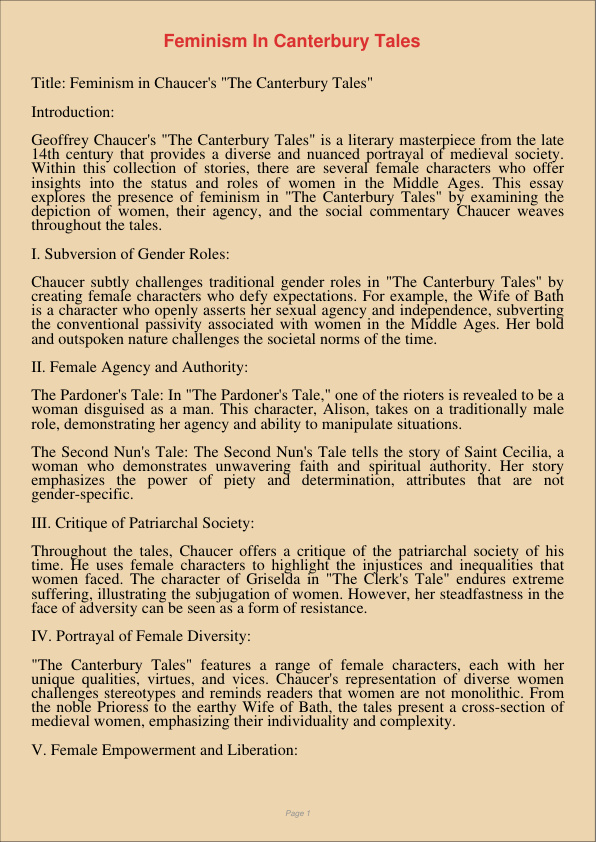
Title: Feminism in Chaucer’s “The Canterbury Tales”
Introduction:
Geoffrey Chaucer’s “The Canterbury Tales” is a literary masterpiece from the late 14th century that provides a diverse and nuanced portrayal of medieval society. Within this collection of stories, there are several female characters who offer insights into the status and roles of women in the Middle Ages. This essay explores the presence of feminism in “The Canterbury Tales” by examining the depiction of women, their agency, and the social commentary Chaucer weaves throughout the tales.
I. Subversion of Gender Roles:
Chaucer subtly challenges traditional gender roles in “The Canterbury Tales” by creating female characters who defy expectations. For example, the Wife of Bath is a character who openly asserts her sexual agency and independence, subverting the conventional passivity associated with women in the Middle Ages. Her bold and outspoken nature challenges the societal norms of the time.
II. Female Agency and Authority:
The Pardoner’s Tale: In “The Pardoner’s Tale,” one of the rioters is revealed to be a woman disguised as a man. This character, Alison, takes on a traditionally male role, demonstrating her agency and ability to manipulate situations.
The Second Nun’s Tale: The Second Nun’s Tale tells the story of Saint Cecilia, a woman who demonstrates unwavering faith and spiritual authority. Her story emphasizes the power of piety and determination, attributes that are not gender-specific.
III. Critique of Patriarchal Society:
Throughout the tales, Chaucer offers a critique of the patriarchal society of his time. He uses female characters to highlight the injustices and inequalities that women faced. The character of Griselda in “The Clerk’s Tale” endures extreme suffering, illustrating the subjugation of women. However, her steadfastness in the face of adversity can be seen as a form of resistance.
IV. Portrayal of Female Diversity:
“The Canterbury Tales” features a range of female characters, each with her unique qualities, virtues, and vices. Chaucer’s representation of diverse women challenges stereotypes and reminds readers that women are not monolithic. From the noble Prioress to the earthy Wife of Bath, the tales present a cross-section of medieval women, emphasizing their individuality and complexity.
V. Female Empowerment and Liberation:
The Wife of Bath’s Prologue: In the Wife of Bath’s Prologue, the character provides an insightful monologue on her views of marriage, which can be interpreted as a call for female empowerment. Her insistence on marital equality and control over her own body align with early feminist ideals.
The Franklin’s Tale: The Franklin’s Tale depicts a woman, Dorigen, who has agency in her own fate. Her willingness to make a sacrifice for her husband is her own choice, illustrating that women in Chaucer’s world could exercise personal agency.
Conclusion:
Geoffrey Chaucer’s “The Canterbury Tales” contains elements of feminism that challenge the traditional roles and expectations of women in medieval society. Through a diverse cast of female characters, Chaucer offers a nuanced view of women’s experiences, demonstrating their agency, diversity, and ability to resist or subvert patriarchal norms. While not a feminist work in the modern sense, “The Canterbury Tales” provides valuable historical insights into the complexities of gender and power in the Middle Ages, and it continues to be a rich source for feminist literary analysis and discourse.
「真诚赞赏,手留余香」
真诚赞赏,手留余香
使用微信扫描二维码完成支付
